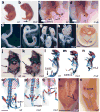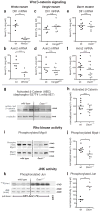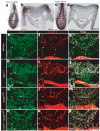Posterior malformations in Dact1 mutant mice arise through misregulated Vangl2 at the primitive streak
- PMID: 19701191
- PMCID: PMC2733921
- DOI: 10.1038/ng.435
Posterior malformations in Dact1 mutant mice arise through misregulated Vangl2 at the primitive streak
Abstract
Mice homozygous for mutations in Dact1 (also called Dapper or Frodo) phenocopy human malformations involving the spine, genitourinary system and distal digestive tract. We traced this phenotype to disrupted germ-layer morphogenesis at the primitive streak. Notably, heterozygous mutation of Vangl2, a transmembrane component of the planar cell polarity (PCP) pathway, rescued recessive Dact1 phenotypes, whereas loss of Dact1 reciprocally rescued semidominant Vangl2 phenotypes. We show that Dact1, an intracellular protein, forms a complex with Vangl2. In Dact1 mutants, Vangl2 was increased at the primitive streak, where cells ordinarily undergo an epithelial-mesenchymal transition. This is associated with abnormal E-cadherin distribution and changes in biochemical measures of the PCP pathway. We conclude that Dact1 contributes to morphogenesis at the primitive streak by regulating Vangl2 upstream of cell adhesion and the PCP pathway.
Figures






References
-
- Yoshikawa Y, Fujimori T, McMahon AP, Takada S. Evidence that absence of Wnt-3a signaling promotes neuralization instead of paraxial mesoderm development in the mouse. Dev Biol. 1997;183:234–42. - PubMed
-
- Veeman MT, Axelrod JD, Moon RT. A second canon: Functions and mechanisms of beta-catenin-independent wnt signaling. Developmental Cell. 2003;5:367–377. - PubMed
Publication types
MeSH terms
Substances
Grants and funding
LinkOut - more resources
Full Text Sources
Medical
Molecular Biology Databases

